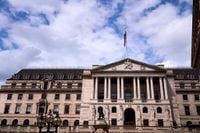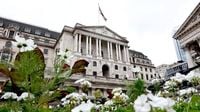On Thursday, September 18, 2025, the Bank of England made a pivotal decision to hold its benchmark interest rate steady at 4%, pausing after a series of cuts that had been aimed at taming persistent inflation. The move, reached by a 7-2 vote among the Monetary Policy Committee (MPC), comes as the UK grapples with the dual challenge of stubbornly high prices and stagnating economic growth. According to BBC News, Bank governor Andrew Bailey cautioned, "We're not out of the woods yet," underscoring the central bank's ongoing wariness about easing monetary policy too quickly.
This latest decision arrives in the wake of fresh data showing UK inflation holding firm at 3.8% in August—unchanged from July and nearly double the Bank's 2% target. Core inflation edged down slightly to 3.6%, while services inflation cooled from 5% to 4.7%. Policymakers predict inflation will tick up to 4% in September before gradually trending down toward target by early 2026. Yet, the path ahead looks anything but straightforward.
The economic backdrop is fraught with uncertainty. Growth was flat in July, fueling fears that the UK could be slipping toward a protracted slowdown. Wage growth, once a bright spot, has also begun to cool in recent months. As Invezz reported, the Bank of England has highlighted both stagnant growth and the weakening labor market as key factors in its decision-making calculus. A softer jobs market might help ease inflationary pressure, but it also raises the risk of prolonged stagnation—a dilemma that leaves policymakers walking a tightrope between supporting growth and keeping prices in check.
The MPC’s cautious tone was echoed by market analysts. Sanjay Raja, chief UK economist at Deutsche Bank, told Invezz, “The good news is that August inflation data has corrected some of the upside surprise we saw last month. The bad news is that CPI has maybe a little further to go before hitting its peak.” He added that the committee would likely prefer “a larger accumulation of evidence before dialing down restrictive policy again.” Deutsche Bank now expects a longer pause before any further rate cuts, with policymakers wary of misreading temporary price movements as the start of a broader trend.
Despite the pause, the mortgage and housing markets have shown a degree of resilience. Stephanie Daley, director of partnerships at mortgage broker Alexander Hall, observed, “The good news is that previous rate cuts have already brought about a greater degree of confidence amongst lenders and buyers. As a result, we’ve seen a greater range of mortgage products introduced in recent months to help drive market activity—from lower deposit offerings to higher loan-to-income multiples.” Daley acknowledged that the rate hold “might not be the decision many wanted to see,” but maintained that the market remains well positioned heading into the year’s final quarter.
Still, not everyone is convinced that stability will translate into renewed momentum. Jonathan Samuels, CEO of Octane Capital, warned, “With inflation stuck at 3.8% and still some way off the Bank of England’s 2% target, wage growth now slowing, and GDP growth flat, the economy remains in a state of limbo.” He added, “Whilst the property market is standing firm, any notable momentum is unlikely to materialise until we see stronger signals of sustained economic recovery.”
Property experts are also bracing for a sluggish winter. Verona Frankish, CEO of estate agency Yopa, told Invezz, “This could result in a far longer winter than many home sellers may have liked, with the chances of Santa leaving a sale completion under the tree this December looking far slimmer.” Yet, she remains optimistic about the long-term outlook, noting, “The long-term picture is one of continued house price growth and a steady and stable level of transactions.”
Beyond interest rates, the Bank of England also announced it would slow the pace at which it reduces its holdings of government bonds—a move designed to minimize disruptions in the gilt market. As BBC News pointed out, the Bank amassed a massive stockpile of government debt during the global financial crisis and the Covid-19 pandemic, peaking at £875 billion. It had been selling off about £100 billion of these bonds annually, but from October 2025, it will cut that pace to £70 billion per year. Governor Bailey explained that this adjustment would allow the Bank to "continue to minimize the impact on gilt market conditions."
Meanwhile, the broader economic landscape remains challenging. The Bank’s regional offices reported that while consumer goods inflation was modest in many areas, food prices remained elevated—rising by 5.1% in the year to August, with beef, butter, milk, and chocolate leading the charge. Businesses told the Bank that the cost of providing consumer-facing services is also up, as higher labor and food costs are passed on where possible. Consumer spending remains subdued in sectors like hotel accommodation and tourism, with demand often centered around special events.
Looking ahead, all eyes are on the Bank’s next policy meeting in November, which comes just before Chancellor Rachel Reeves unveils the government’s Autumn Budget on November 26. Reeves is widely expected to announce tax rises aimed at closing the fiscal gap—a move that could further influence the Bank’s policy stance. As BBC News noted, the higher cost of servicing the UK’s debt pile may limit the government’s room for maneuver, adding another layer of complexity to the policy outlook.
Political reactions have been swift. Shadow chancellor Sir Mel Stride criticized the government, saying, “The fact interest rates are not coming down faster is a result of Labour's reckless decisions which have pushed up inflation.” Such comments reflect the heated debate over the right mix of fiscal and monetary policy in a period marked by economic uncertainty.
For now, the Bank of England appears committed to a wait-and-see strategy. Interest rates sit at their lowest level since early 2023, but the central bank has made it clear that it is not yet ready to declare victory over inflation. As Governor Bailey put it, “I continue to think there will be some further reductions but the timing and scale of those is more uncertain now.”
With inflation proving stubborn, growth faltering, and fiscal policy in flux, the coming months promise to be a delicate balancing act for the UK’s policymakers. The decisions made this autumn could set the tone for the country’s economic trajectory well into 2026.

